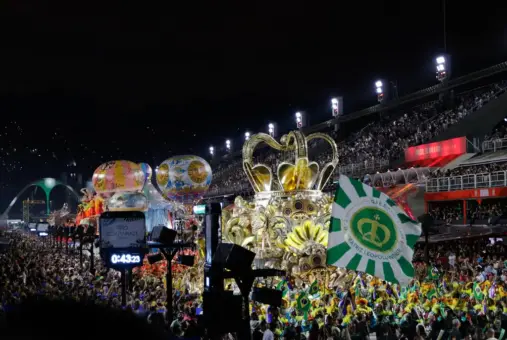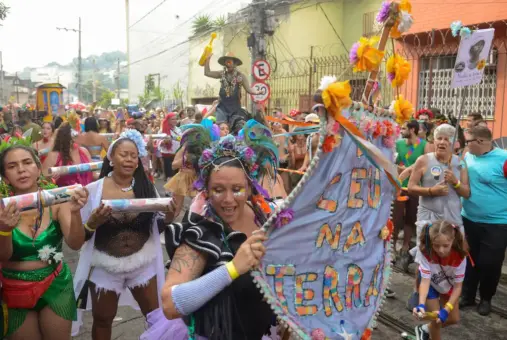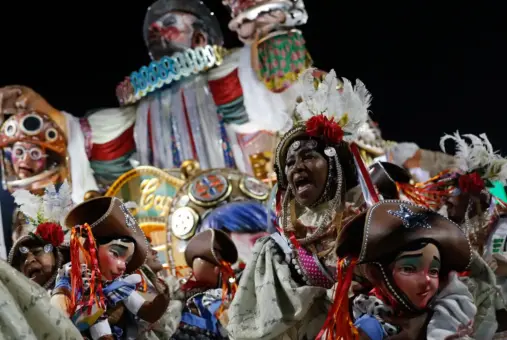Known for its abundance of colors and bodies, for its exuberant exuberance and for its crowds in streets and avenues, Brazilian Carnival is also a serious matter that involves work, dedication, tradition, power and traditional knowledge – and, as such, it is full of stories for journalists.
The biggest popular festival in Brazil – covering everything from detailed local traditions to fierce and million-dollar competitions in the case of samba schools – Carnival requires complex coverage, which ranges from media outlets specializing in the theme to all the biggest television stations and newspapers in the country.
Preparation for the festivities lasts for months – in many cases, since the end of last year's Carnival –, with its peak that runs from Saturday, Feb. 10, until noon on Wednesday, Feb. 13. The celebrations require special attention from the press, from study and sociological knowledge about the parties, to, in the case of foreign correspondents, basic notions of Brazil, including, for example, its climate during the summer and its dress codes.
To understand how to cover the festivities, LatAm Journalism Review (LJR) spoke to a group of experienced journalists who specialize in the topic. For logistical reasons, the interviewees were all from Rio de Janeiro, which has the most famous carnival party internationally, although large celebrations take place throughout the country and these tips are also valid for those locations.

The Imperatriz Leopoldinense samba school, winner of the Special Group championship in 2023, participates in the Champions Parade at the Sambadrome Marquês de Sapucaí ( Photo: Fernando Frazão/Agência Brasil)
In addition to reinforcing items valid for any journalistic project, such as the importance of preparation and research before reporting, all interviewees warned against superficial and stereotypical coverage, which reinforces clichés and is limited to a celebrity culture, instead of approaching – with complexity – a plural celebration that is full of creativity and work, and that is constantly changing.
There was a consensus among interviewees on the importance of exploring the cultural, ethnic and social diversity present at the event, with an emphasis on the value of highlighting individual dramas, collective efforts and the unique experiences of participants.
“Carnival is a fantastic spectacle, full of special effects and beautiful women. But behind this there are thousands of people who spent months preparing, made sacrifices and left their families aside. Often, the press focuses only on celebrities, who have their place, and forgets to tell other people's stories,” Anderson Baltar, anchor at Rádio Arquibancada, the largest radio specializing in Carnival parades in Brazil, told LJR. Since 2015, he has been professor of a course for journalists specializing in the subject.
“There are thousands of stories to be told, including stories of religious and social persecution. Carnival is a big arena where thousands of people who are invisible have their big stage,” he added.
First, it’s important for those outside Brazil and who are unfamiliar with Carnival culture to know that there is a specific language for the festivities.
For instance, a bloco is a kind of street party that features music, dancing, costumes, drinking and other festivities now common to Rio, São Paulo and other places. Other cities, like Olinda, in Pernambuco, have their own traditions and dynamics.
In the current blocos, all sorts of music styles can be heard, from techno to American pop played by brass bands. In Rio, a very traditional style is called marchinha de carnaval. Usually, it consists of a short melody of a few verses with lyrics that are often poetic or play on words.

On February 3, 2024, people dressed in costumes and carrying musical instruments enthusiastically participate in the parade of the Céu Na Terra block in Rio de Janeiro (Photo: Thomaz Silva: Agência Brasil)
The situation is different for samba-schools, though: in that case, a variation of samba, called samba-enredo – literally, samba-story, a variation of a samba that tells a story – fills all spaces.
Different neighborhoods or communities have their own samba schools, composed of thousands of dancers, drummers and musicians who practice all year to compete in the Avenida Marquês de Sapucaí. Each school has a different color and every year they have a new theme, with music, costumes and floats that are designed accordingly.
Though there are hundreds of other terms that go along with the celebration, this is a start.
Carnival in Rio is divided between the samba school parades, which take place during the night and early morning, and the street blocos, which bring together millions of people spread across hundreds of parties mainly during the day.
Specializing in covering samba schools, Baltar gives a series of technical tips for those going to Avenida Marquês de Sapucaí, where the parades take place.
“Carnival coverage has many similarities with sports coverage. But there’s no mixed zone or press conference, it’s everyone for themselves,” he said. “You have to be very careful not to be surprised. Furthermore, school directors are very attentive. If someone is disturbing people, they will approach that person.”
The journalist suggests that newbies observe how other professionals work. On the day of the parades, he suggests short interviews.
“The Sapucaí environment is not very conducive to in-depth interviews. Everyone is a nervous wreck, you’re not going to stop someone right then and do a very in-depth interview.”
Before the parade, he suggests that they contact the schools themselves, which have well-organized press offices, and ask for relevant information and characters for stories.“The parade is the only competition between neighborhoods that has global repercussions. It is the biggest competition between neighborhoods in the world,” he stated.
In addition, he gives practical tips, such as staying hydrated and being physically prepared for long hours of work on your feet. As the parade takes the entire night, the recommendation is to arrive as rested as possible. It is also necessary to wear comfortable clothes and bring a raincoat.
“Sapucaí is the only place in the world where everyone works in shorts,” he said.
Leila Youssef, who is responsible for producing, coordinating and planning coverage for the newspaper O Globo and who has around 20 Carnival reporting experiences, highlights the value of details in coverage.
“It's a huge show, and you win in terms of coverage when you bring interesting details, especially for outlets without live broadcasts. Coverage wins when it brings interesting details within the bigger picture. This applies to the avenue and the street carnival,” Youssef told LJR.
“When, during a parade, 3,000 people parade for 70 minutes, a single scene is what will attract attention. You can see the parade as a whole on TV or on the internet. But, if you tell a story about a dancer, someone who danced so much that their foot bled, or the drama of a wing of dancers, the coverage comes to life,” she added.

During Imperatriz's parade in 2023, a woman stands out wearing a costume in tribute to the famous Brazilian bandit Lampião (Photo: Fernando Frazão/Agência Brasil)
The same, according to her, applies to street Carnival. Each year, the event becomes bigger, and involves millions of people spread across hundreds of parties, which can range from dozens of revelers to hundreds of thousands of people.
“Last year, one of the coolest stories we did was when the entire block stopped and sat on the street to find a missing child. As coordinator, I always tell teams to look for the details in the big story,” Youssef said.
In addition to practical tips, it is also necessary to take into account the cultural complexity of the event. For journalist and researcher João Gustavo Melo, author of “Vestidos para brilhar: Uma epopeia dos grandes destaques do Carnaval carioca” (Dresses to shine: An epic of the great highlights of Carnival in Rio), the journalist who covers the samba school parades needs to understand Brazilian culture and religiosity, and “not simplify things that are sometimes complex.”
“It is an opportunity to reveal other Brazils that escape the obvious and are outside the disenchanted experience of capitalism. You can tell stories of populations and people who are silenced and not really heard from,” he told LJR.
Also a protagonist in the production of Carnival, as a composer at the Viradouro samba school, Melo said that “the first thing a journalist can do wrong is to do something superficial about an event that lasts all year.”
According to him, many press professionals “don’t even investigate the basics. They arrive at the home base and ask ‘what color is this school,” something that can be found on Google in a minute,” he said.
“Another frequently asked question is ‘who are the celebrities who are going to parade at the school?’ For us, the celebrities are, for example, the drummers, the residents of the neighborhood. But many want to know about people in the media.”
To learn, Melo suggested that newcomers visit specialized websites, such as Rádio Arquibancada, Carnavalesco and Carnaval Carioca.
Despite highlighting the importance of preparation, Melo also valued the importance of the layman's perspective, who sometimes notices elements already naturalized by those who experience it every day.
“We need the enchanted look of the layman, looking at things that for us are common scenery. Sometimes a journalist who is not so informed, so immersed in this universe, brings up questions that have not been thought of before,” he said.
Bárbara Pereira, journalist for TV Brasil and author of the books about Carnival “Estrela que me faz sonhar” (Star that makes me dream) and “Pé, cadeira e cadência” (Foot, hips and cadence), cites an expression used by authors Luiz Antonio Simas and Ney Lopes to describe the celebration: Carnival, according to all three, it is “a cultural complex.” That is, a set of distinct elements that involves “aspects of sociability, transmission of knowledge, and the formation of Rio and Brazilian society itself,” Pereira told LJR.
“The most obvious things about Carnival are the economy and happiness, but there are very different cultures. You go to a samba school and think there is uniformity there, but there isn't. Each nucleus is a microuniverse,” the researcher said.
Pereira talks about “Carnival wings,” sectors of a samba school that participate in the parade during the festivities in Brazil. Each "wing" typically represents a theme or concept, and consists of performers, dancers, or musicians, often with specific social profiles.
“The wing of baianas is a different universe from the flag bearer. They mix, but they have their own different foundations. Each aspect involves different ways of life,” she added, referring to two traditional positions in the parade.
Pereira observes that a similar dynamic exists in relation to street Carnival. The coverage, according to her, sometimes forgets that, behind a group that forms a local Carnival bloco, there is often a specific relationship with the territory, and stories that are often made invisible.
“Sometimes, for example, it could be musicians who have difficulty performing for the rest of the year, or neighbors who wanted to celebrate something. It is necessary to understand how that group was formed, what their sociability relationships are, and what their relationship with the territory is,” Pereira said. “Each place has its own idea of playing, and this playful aspect is very important for Brazil.”
The emphasis on addressing aspects linked to pleasure, such as sexuality and sensuality present in Carnival, sometimes hides important internal dimensions, such as the possibility of experimenting with other identities, Pereira said.
“Often, we only talk about the profane aspect, and forget that the party has a reason, like celebrating life, or putting an end to a bad year. There is a cathartic element behind the moment. Carnival is where you can dress however you want and no one will ridicule you, because this playful aspect is part of the process,” the researcher said.